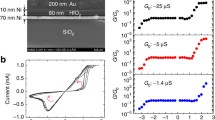Abstract
An implementation of associative memory based on a Hopfield network is described. In the proposed approach, memory addresses are regarded as training vectors of the artificial neural network. The efficiency of memory search is directly associated with solving the overfitting problem. A method for dividing the training and input network vectors into parts, the processing of which requires a smaller number of neurons, is proposed. Results of a series of experiments conducted on Hopfield network models with different numbers of neurons trained with different numbers of vectors and operated under different noise conditions are presented.
Similar content being viewed by others
REFERENCES
Karpov, Yu.L., Karpov, L.E., and Smetanin, Yu.G., Adaptation of general concepts of software testing to neural networks, Program. Comput. Software, 2018, vol. 44, no. 5, pp. 324–334. https://doi.org/10.1134/S0361768818050031
Karpov, Yu.L., Karpov, L.E., and Smetanin, Yu.G., Elimination of negative circuits in certain neural network structures to achieve stable solutions, Program. Comput. Software, 2019, vol. 45, no. 5, pp. 241–250. https://doi.org/10.1134/S0361768819050025
Karpov, Yu.L., Volkova, I.A., Vylitok, A.A., Karpov, L.E., and Smetanin, Yu.G., Designing interfaces for classes of a neural network graph model, Program. Comput. Software, 2020, vol. 46 (in press).
Hopfield, J.J., Neural networks and physical systems with emergent collective computational properties, Proc. Nat. Acad. Sci. USA, 1982, vol. 79, pp. 2554–2558.
Smetanin, Yu.G., Neural networks as systems for recognizing patterns, J. Math. Sci., 1998, vol. 89, no. 4, pp. 1406–1457.
Hebb, D.O., The Organization of Behavior, Wiley, 1948.
Amit, D.J., Gotfreund, H., and Sompolinski, H., Spin-glass models of neural networks, Phys. Rev. A, 1985, vol. 32, p. 1007.
McEliece, R.J., Posner, E.G., Rodemich, E.R., and Venkatesh, S.S., The capacity of the Hopfield associative memory, IEEE Trans. Inf. Theory, 1987, vol. 33, no. 4, pp. 461–482.
Venkatesh, S.S., Computation and learning in the context of neural network capacity, Neural Networks for Perceptions, Wechsler, H., Ed., Academic, 1992, vol. 2, pp. 173–207.
Makhoul, J., El-Jaroudi, A., and Schwartz, R., Formation of disconnected regions with a single hidden layer, Proc. Int. Joint Conf. Neural Networks, Washington, 1989, vol. 1, pp. 455–460.
Myers, G.J., The Art of Software Testing, Wiley, 1979.
Kaner, C., Falk, J., and Nguyen, H.Q., Testing Computer Software, International Thompson Publishing Press, 1999, 2nd ed.
Tamres, L., Introducing Software Testing, Addison Wesley, 2002.
Beizer, B., Software Testing Techniques, Van Nostrand Reinhold, 1990, 2nd ed.
UCI Machine Learning Repository. https://archive.ics.uci.edu/ml/datasets/Beijing+PM2.5+Data#
Funding
This work was supported by the Russian Foundation for Basic Research, project nos. 18-07-00697-а, 18-07-01211-а, 19-07-00321-а, and 19-07-00493-а.
Author information
Authors and Affiliations
Corresponding authors
Additional information
After the publication of this paper, the inspirer of our work, Yurii Gennad’evich Smetanin, untimely passed away. He did not leave his work until the very end, discussing plans for future researches and experiments by telephone from the hospital. The bright memory of our friend, a true scientist and a very good person, will remain with us forever.
Translated by Yu. Kornienko
Rights and permissions
About this article
Cite this article
Karpov, Y.L., Karpov, L.E. & Smetanin, Y.G. Some Aspects of Associative Memory Construction Based on a Hopfield Network. Program Comput Soft 46, 305–311 (2020). https://doi.org/10.1134/S0361768820050023
Received:
Revised:
Accepted:
Published:
Issue Date:
DOI: https://doi.org/10.1134/S0361768820050023




